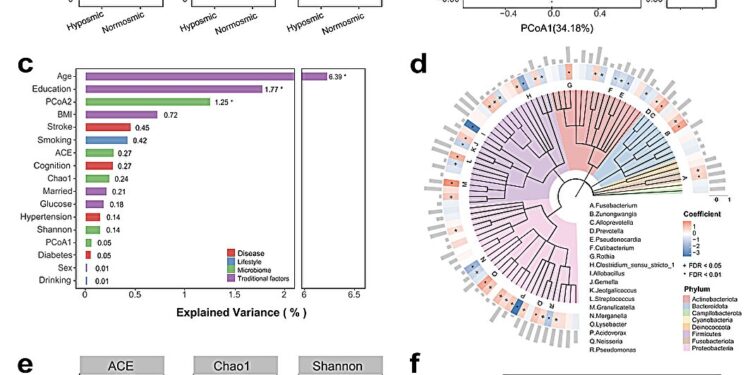Differences in the nasal microbiome between hyposmic and normal groups. Credit: Translational psychiatry (2025). DOI: 10.1038 / S41398-025-03346-Y.
As humans age, in particular after the average age, their brain functions, their cognitive capacities and their memory can deteriorate to various degrees. Aging disorders marked by a cognitive decline, in particular dementia, are more and more widespread in recent decades.
The estimates suggest that the number of individuals diagnosed with dementia could go from 55 million in 2019 to around 139 million by 2050. Understanding the factors contributing to cognitive decline and the design of methods to detect the first signs of dementia is therefore of the greatest importance, because it could help to reliably resume its emergence and its therapeutic interventions.
In recent years, some studies have found a link between the ability of people to perceive and identify odors (that is, olfactory function) and their cognitive capacities as older adults. Although the relationship between olfactory dysfunction and cognitive decline is now well documented, one causes the other or the result of similar mechanisms linked to aging or neurodegenerative remains uncertain.
Researchers from Fudan University in China recently carried out a study to further explore the link between olfactory dysfunction and cognitive decline in the elderly. Their results, published in Translational psychiatrysuggest that the nasal microbiome (that is to say all microorganisms residing in the nasal passages of each individual) could contribute to the relationship between the olfactory function and cognitive health.
“Emerging evidence has stressed that the olfactory dysfunction, a common characteristic of aging, is increasingly linked to the cognitive decline in the elderly,” wrote Huiling Song, Jiaojiao Zou and their colleagues.
“However, research on the underlying mechanism, in particular the role of the nasal microbiome, remains limited. In this study, we studied associations between olfactory function, nasal microbiome and cognition in 510 elderly people with an average age of 77.9 years.”
Differences in the nasal microbiome between light cognitive deficiencies (MCI) and cognitively healthy groups. Credit: Translational psychiatry (2025). DOI: 10.1038 / S41398-025-03346-Y
As part of their study, the researchers recruited 510 elderly people and examined their olfactory function, nasal microbiobs and cognitive capacities. Their olfactory function was evaluated using a procedure known as brief Chinese identification test of the odor.
To test the cognitive capacities of the study participants, the researchers asked them to finish tests on the basis of two psychometric measures, known as the mini-mental examination and a revised scale of dementia Hasegawa. Finally, they generated microbiome profiles for each participant using a method known as sequencing the 16S RNA gene.
“We have observed that the olfactory dysfunction (i.e. the hyposmy) was associated with a higher wealth of nasal bacteria, and such an observation was reproduced in a set of external data,” wrote Song, Zou and their colleagues. “A total of 18 nasal bacterial genres have been identified as associated with the olfactory function, with eight genres such as Acidovorax and Morganella enriched in the hyposmic group.”
When they analyzed the data they have collected, the researchers unveiled correlations between certain microbial profiles and different levels of cognitive impairments. In fact, they found that people with microbiome profiles marked by a prevalence of certain kinds of bacteria have proven to have lower cognitive impairments than those which mainly contained other genres of bacteria.
“A composite microbial index of the nasal olfactory function has considerably improved the reclassification accuracy of the traditional risk model in the hyposmic distinction of normal participants (p = 0.008)”, wrote Song, Zou and their colleagues. “In addition, participants with a nasal biotype dominated by corynebacterium had a lower prevalence of light cognitive impairment compared to those dominated by Dolosigranulum or Moraxella.”
Overall, the results suggest that the types of bacteria populate the noses of individuals could contribute to the previously reported link between the olfactory function of the elderly and cognition.
In the future, their study could open the way for new research by focusing on the nasal microbiome profiles they have identified, which could help to design new strategies to detect early cognitive decline and plan targeted treatments.
More information:
Huiling Song and Al, nasal microbiome compared to olfactory dysfunction and cognitive decline in the elderly, Translational psychiatry (2025). DOI: 10.1038 / S41398-025-03346-Y.
© 2025 Science X Network
Quote: The nasal microbiome can help explain the link between olfactory dysfunction and cognitive decline (2025, April 28) recovered on April 28, 2025 from
This document is subject to copyright. In addition to any fair program for private or research purposes, no part can be reproduced without written authorization. The content is provided only for information purposes.



